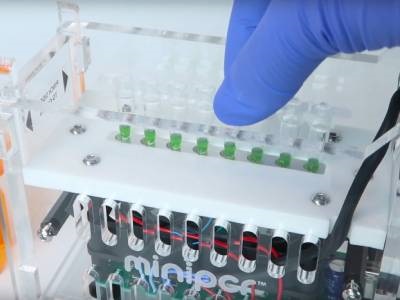
Polymerase chain reaction (PCR) has become an essential tool in countless labs, serving a key role in applications ranging from clinical diagnostics and biopharmaceutical research to next-generation sequencing and forensic testing. While invaluable for these applications, the size and cost of PCR instruments are limiting factors for use outside a traditional laboratory setting. For biologists performing work out in the field, students learning about life science in classrooms and astronauts conducting one-of-a-kind experiments within the confines of the International Space Station (ISS), accessible lightweight, mobile tools can expand the scope of what they can accomplish in their respective settings.
Ezequiel Alvarez Saavedra, an MIT graduate with a PhD in genetics, and Sebastian Kraves, who received his PhD in neurobiology from Harvard Medical School, recognized the barriers preventing many from harnessing the benefits of PCR technology, and envisioned a system both small enough to fit in your pocket and affordable enough to not burn a hole through it. Together, the pair launched their company miniPCR bio in 2013, introducing a new thermal cycling device that could let anyone, anywhere, conduct DNA experiments.
The miniPCR, which comes in 8- or 16-well formats, trades the thermoelectric components of a traditional PCR machine for a lightweight fan and thin-film heater, cutting back the system’s cost and allowing it to travel freely outside the lab. The battery-powered device with USB connectivity is just over 5 cm thick, less than 13 cm wide and about 10 cm tall. Weighing just about 1 pound, the device is not much bigger than a mobile phone, and comparable in price as well; the 8-well version costs just $650.
Although this miniaturized PCR system comes in bright neon colors and is partly geared toward middle school and high school students, the miniPCR is not a toy or merely a high-tech study aid; the device is a functional PCR machine, compatible with standard PCR reagents and consumables, and has been utilized by career researchers in applications including virus and animal genome sequencing, point-of-care diagnostics and CRISPR-Cas9 gene editing. In one case, a researcher at a field laboratory in Sierra Leone bought miniPCR machines for training, but found them to be effective enough that he ended up using them for his Ebola virus sequencing project, according to Alvarez Saavedra.
The miniPCR has also been used in agriculture to detect pathogens, trace GMOs and improve cultivation and yield through sequencing of plants and fungi out in the field or orchard. Animal sequencing in remote areas, such as the rainforests of Madagascar, has been conducted with help from the portable device in efforts related to biodiversity and conservation. Forensic labs have also shown interest in the machine; one lab began using it for STR analysis after finding results to be comparable to those attained from a benchtop PCR machine, according to a case study on the miniPCR bio website. The fieldability of the device would allow DNA to be amplified closer to the source, reducing risks of degradation and contamination.
“miniPCR can be taken to the point of need,” Kraves told Labcompare. “Field, diagnostic site, or even the International Space Station.”
The device was introduced on the ISS in 2016 as part of the first Genes in Space mission, and is used alongside other compact tools suitable for the unique environment. This suite of miniaturized tools has been used to identify unknown microbes in the station for the first time, as well as other outer space experiments ranging from DNA sequencing to gene editing. “Mini” equipment offers astronauts the advantages of conserving energy and bench space, and reduces the need to shuttle samples and bulky components between the station and Earth.
“Our equipment is less power intensive, which makes it feasible to operate on batteries, solar panels, or just to reduce your carbon footprint,” Kraves explained.
One ongoing effort involving the miniaturized equipment is being conducted at the University of Namibia Biomedical Research Lab, where scientists are working to develop new diagnostic tests for malaria using the portable device in conjunction with Bluetooth-connected smartphones. Kraves added that miniPCR has been used by amateur biologists in areas such as cannabis testing and molecular mycology, and some researchers have developed protocols using miniPCR to streamline COVID-19 diagnostic testing.
The educational component of miniPCR bio ties learning to real-life applications ranging from animal genetics to forensic investigations. The machine connects to a mobile app that provides visualizations to help students understand the data behind their experiment. During the COVID-19 pandemic, miniPCR devices have aided in virtual learning, with teachers demonstrating learning labs from home. The company also hosts the Genes in Space contest for students to design experiments for ISS astronauts to perform.
Miniaturized laboratory equipment provides scientists and students alike with unique opportunities to perform mobile, flexible and budget-friendly experiments. In addition to their PCR device, miniPCR bio also offers compact gel electrophoresis systems, and other examples include the minION DNA sequencing device by Oxford Nanopore Technologies and the compact, low-power GLACIER cryogenic freezer designed at the University of Alabama at Birmingham, both of which are also used on the ISS. With continuing advancements in microfluidics, lightweight materials in nanoengineering, further additions to the mini lab toolkit could be in store for the future.
Photos: Courtesy of miniPCR bio